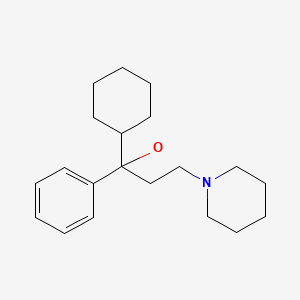Attribution Statement: LactMed is a registered trademark of the U.S. Department of Health and Human Services.
NCBI Bookshelf. A service of the National Library of Medicine, National Institutes of Health.
Drugs and Lactation Database (LactMed®) [Internet]. Bethesda (MD): National Institute of Child Health and Human Development; 2006-.
CASRN: 144-11-6

Drug Levels and Effects
Summary of Use during Lactation
Limited information indicates that maternal doses of trihexyphenidyl up to 4 mg daily together with haloperidol or risperidone did not produce any adverse effects in breastfed infants. Long-term use of trihexyphenidyl might reduce milk production or milk letdown, but a single dose is not likely to interfere with breastfeeding. The prolactin elevating effect of concurrent antipsychotic agents might counteract any prolactin lowering effect of trihexyphenidyl. During long-term use, observe for signs of decreased lactation (e.g., infant insatiety and poor weight gain).
Drug Levels
Maternal Levels. Relevant published information was not found as of the revision date.
Infant Levels. Relevant published information was not found as of the revision date.
Effects in Breastfed Infants
One woman with schizophrenia took trihexyphenidyl and haloperidol during 3 pregnancies and postpartum. The trihexyphenidyl dose was 4 mg daily in all 3 pregnancies. She breastfed (extent not stated) all 3 children for 6 to 8 months using the same doses. Development was age-appropriate in all children aged 16 months at 8 years of age at the time of assessment.[1]
A woman diagnosed with undifferentiated schizophrenia took risperidone 4 to 5 mg and trihexyphenidyl 2 mg daily throughout 5 pregnancies. She breastfed each infant for 20 to 24 months. No adverse developmental consequences were noted in any of the children. At the time of publication, the oldest three children, aged 26, 23 and 22 years, had completed their education and were employed, while the youngest two were 15 and 19 years old and were doing well academically in their education.[2]
Effects on Lactation and Breastmilk
Anticholinergics can inhibit lactation in animals, apparently by inhibiting growth hormone and oxytocin secretion.[3-7] Anticholinergic drugs can also reduce serum prolactin in nonnursing women.[8] The prolactin level in a mother with established lactation may not affect her ability to breastfeed.
One woman with schizophrenia took trihexyphenidyl and haloperidol during 3 pregnancies and postpartum. She was able to breastfeed (extent not stated) all 3 children for 6 to 8 months.[1]
A woman diagnosed with undifferentiated schizophrenia took risperidone 4 to 5 mg and trihexyphenidyl 2 mg daily throughout 5 pregnancies. She successfully breastfed each infant for 20 to 24 months.[2]
References
- 1.
- Mendhekar DN, Andrade C. Uneventful use of haloperidol and trihehexyphenidyl during three consecutive pregnancies. Arch Womens Ment Health 2011;14:83-4. [PubMed: 21116668]
- 2.
- Mendhekar D, Andrade C. A 26-year follow-up of a woman with 5 consecutive children exposed to risperidone during pregnancy and breastfeeding. Prim Care Companion CNS Disord 2024;26:23cr03660. [PubMed: 38300980]
- 3.
- Aaron DK, Ely DG, Deweese WP, et al. Reducing milk production in ewes at weaning using restricted feeding and methscopolamine bromide. J Anim Sci 1997;75:1434-42. [PubMed: 9250502]
- 4.
- Powell MR, Keisler DH. A potential strategy for decreasing milk production in the ewe at weaning using a growth hormone release blocker. J Anim Sci 1995;73:1901-5. [PubMed: 7592071]
- 5.
- Daniel JA, Thomas MG, Powell MR, Keisler DH. Methscopolamine bromide blocks hypothalmic-stimulated release of growth hormone in ewes. J Anim Sci 1997;75:1359-62. [PubMed: 9159285]
- 6.
- Bizzarro A, Iannucci F, Tolino A, et al. Inhibiting effect of atropine on prolactin blood levels after stimulation with TRH. Clin Exp Obstet Gynecol 1980;7:108-11. [PubMed: 6788407]
- 7.
- Svennersten K, Nelson L, Juvnäs-Moberg K. Atropinization decreases oxytocin secretion in dairy cows. Acta Physiol Scand 1992;145:193-4. [PubMed: 1636447]
- 8.
- Masala A, Alagna S, Devilla L, et al. Muscarinic receptor blockade by pirenzepine: Effect on prolactin secretion in man. J Endocrinol Invest 1982;5:53-5. [PubMed: 6808052]
Substance Identification
Substance Name
Trihexyphenidyl
CAS Registry Number
144-11-6
Drug Class
Breast Feeding
Milk, Human
Antiparkinson Agents
Muscarinic Antagonists
Parasympatholytics
Disclaimer: Information presented in this database is not meant as a substitute for professional judgment. You should consult your healthcare provider for breastfeeding advice related to your particular situation. The U.S. government does not warrant or assume any liability or responsibility for the accuracy or completeness of the information on this Site.
- User and Medical Advice Disclaimer
- Drugs and Lactation Database (LactMed) - Record Format
- LactMed - Database Creation and Peer Review Process
- Fact Sheet. Drugs and Lactation Database (LactMed)
- Drugs and Lactation Database (LactMed) - Glossary
- LactMed Selected References
- Drugs and Lactation Database (LactMed) - About Dietary Supplements
- Breastfeeding Links
- PubChem SubstanceRelated PubChem Substances
- PubMedLinks to PubMed
- Review Flavoxate.[Drugs and Lactation Database (...]Review Flavoxate.. Drugs and Lactation Database (LactMed®). 2006
- Review Oxybutinyn.[Drugs and Lactation Database (...]Review Oxybutinyn.. Drugs and Lactation Database (LactMed®). 2006
- Review Clobazam.[Drugs and Lactation Database (...]Review Clobazam.. Drugs and Lactation Database (LactMed®). 2006
- Review Benztropine.[Drugs and Lactation Database (...]Review Benztropine.. Drugs and Lactation Database (LactMed®). 2006
- Review Tropicamide.[Drugs and Lactation Database (...]Review Tropicamide.. Drugs and Lactation Database (LactMed®). 2006
- Trihexyphenidyl - Drugs and Lactation Database (LactMed®)Trihexyphenidyl - Drugs and Lactation Database (LactMed®)
Your browsing activity is empty.
Activity recording is turned off.
See more...
